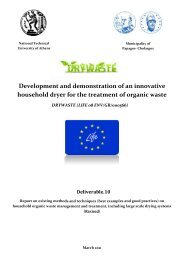MOROCOMP (LIFE TCY05/MA000141) - Unit of Environmental ...
MOROCOMP (LIFE TCY05/MA000141) - Unit of Environmental ...
MOROCOMP (LIFE TCY05/MA000141) - Unit of Environmental ...
You also want an ePaper? Increase the reach of your titles
YUMPU automatically turns print PDFs into web optimized ePapers that Google loves.
equire longer composting periods while the excess carbon is used by the microorganisms.<br />
The rate at which carbon compounds decompose must also be considered. If the<br />
carbon is in a form that is difficult to decompose, the composting rate may be slower<br />
(e.g. wood waste). Since decomposition occurs on particle surfaces, degradability can<br />
be improved by reducing the particle size as long as porosity is not a problem (see<br />
above). If required, the C:N ratio can be adjusted to increase the proportion <strong>of</strong> carbon<br />
to compensate for the presence <strong>of</strong> poorly degradable sources <strong>of</strong> carbon. This may,<br />
however, results in a longer composting time period.<br />
2.4. pH<br />
The composting process is relatively insensitive to pH within the range commonly<br />
found in mixtures <strong>of</strong> organic materials. The composting process can work over a wide<br />
spectrum <strong>of</strong> pH values, but a range <strong>of</strong> between 6.0 and 8.5 is preferred [2, 3, 4, 5, 6].<br />
Although the composting process will be less effective at the extreme ranges <strong>of</strong> 5.5<br />
and 9.0 it will still work. A pH above 8.5 encourages the conversion <strong>of</strong> nitrogen<br />
compounds to ammonia, which further adds to the alkalinity. Adjustment <strong>of</strong> the pH<br />
downward below 8.0 to reduce the ammonia loss is possible by using additives. As<br />
decomposition occurs the composition <strong>of</strong> the raw materials and the associated pH<br />
change. However, irrespective <strong>of</strong> the pH <strong>of</strong> the starting raw materials, the composting<br />
process yields a final composted organic material with a stable pH that is close to<br />
neutral (7.0).<br />
2.5. Moisture<br />
Moisture supports the metabolic processes <strong>of</strong> the micro-organisms. Water is the<br />
medium for chemical reactions, transportation <strong>of</strong> nutrients and allows the<br />
microorganisms to move about. Biological activity ceases below 15% moisture<br />
content and in theory activity is optimal when materials are saturated. Generally<br />
moisture content <strong>of</strong> between 40% and 65% should be maintained. At moisture content<br />
<strong>of</strong> below 40%, micro-organism activity will continue but at a slower rate and above<br />
65% water will displace much <strong>of</strong> the air in the pore spaces <strong>of</strong> the composting material.<br />
14










